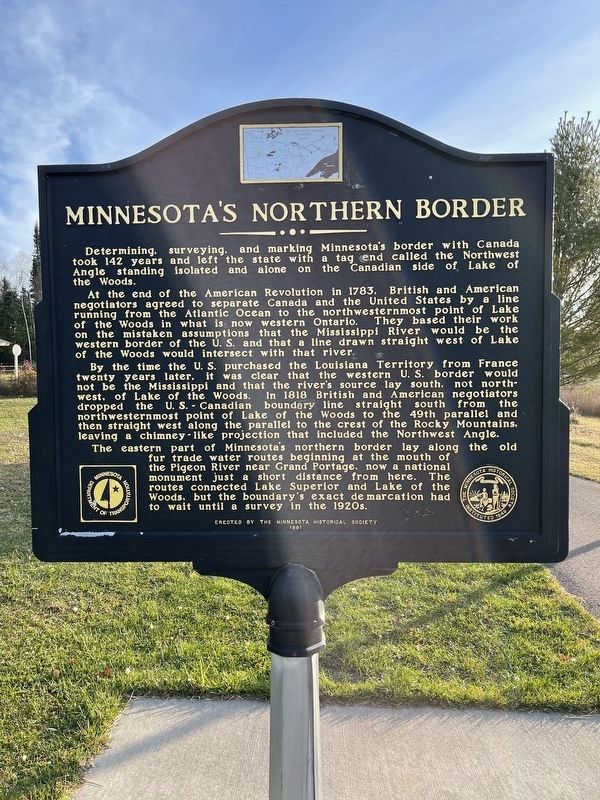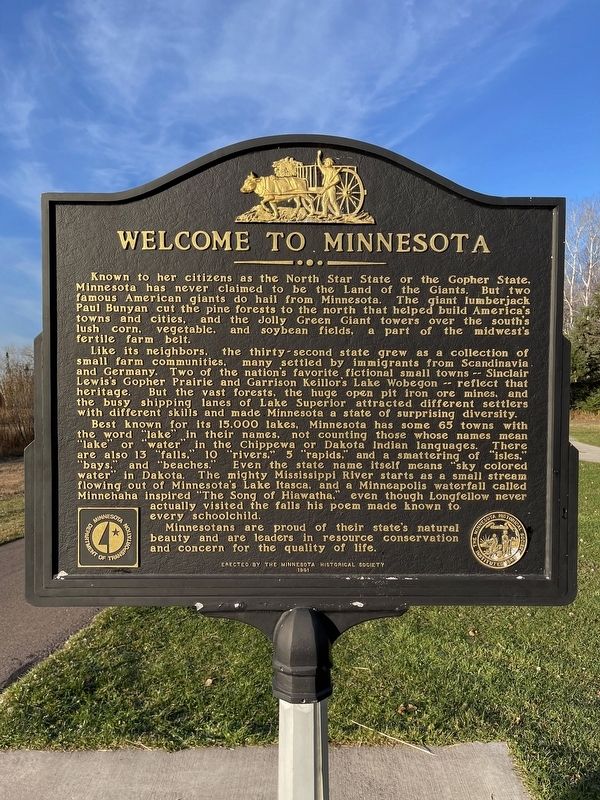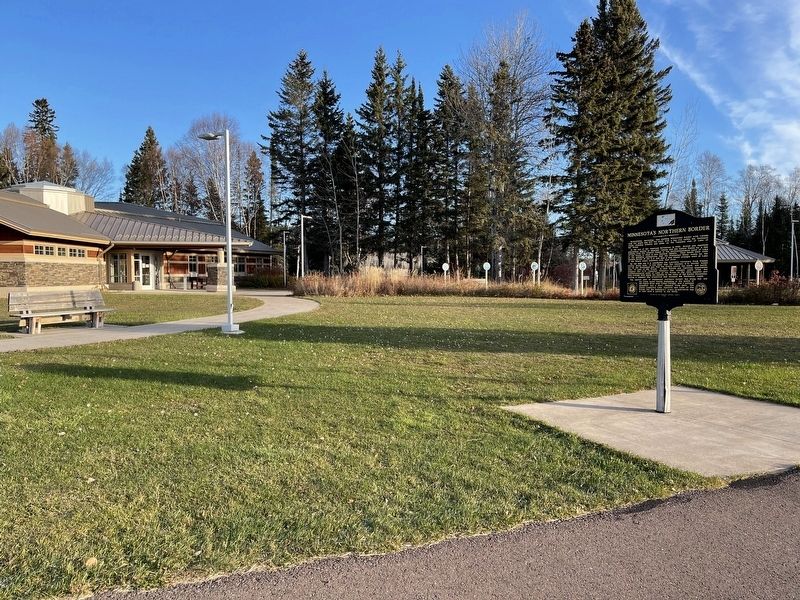Grand Portage in Cook County, Minnesota — The American Midwest (Upper Plains)
Minnesota's Northern Border / Welcome to Minnesota
Inscription.
Minnesota's Northern Border
Determining, surveying, and marking Minnesota’s border with Canada took 142 years and left the state with a tag end called the Northwest Angle standing isolated and alone on the Canadian side of Lake of the Woods.
At the end of the American Revolution in 1783, British and American negotiators agreed to separate Canada and the United States by a line running from the Atlantic Ocean to the northwesternmost point of Lake of the Woods in what is now western Ontario. They based their work on the mistaken assumptions that the Mississippi River would be the western border of the U.S. and that a line drawn straight west of Lake of the Woods would intersect with that river.
By the time the U.S. purchased the Louisiana Territory from France twenty years later, it was clear that the western U.S. border would not be the Mississippi and that the river’s source lay south, not northwest, of Lake of the Woods. In 1818 British and American negotiators dropped the U.S.-Canadian boundary line straight south from the northwesternmost point of Lake of the Woods to the 49th parallel and then straight west along the parallel to the crest of the Rocky Mountains, leaving a chimney-like projection that included the Northwest Angle.
The eastern part of Minnesota’s northern border lay along the old fur trade water routes beginning at the mouth of the Pigeon River near Grand Portage, now a national monument just a short distance from here. The routes connected Lake Superior and Lake of the Woods, but the boundary’s exact demarcation had to wait until a survey in the 1920s.
Welcome to Minnesota
Known to her citizens as the North Star State or the Gopher State, Minnesota has never claimed to be the Land of the Giants. But two famous American giants do hail from Minnesota. The giant lumberjack Paul Bunyan cut the pine forests to the north that helped build America’s towns and cities, and the Jolly Green Giant towers over the south’s lush corn, vegetable, and soybean fields, a part of the midwest’s fertile farm belt.
Like its neighbors, the thirty-second state grew as a collection of small farm communities, many settled by immigrants from Scandinavia and Germany. Two of the nation’s favorite fictional small towns - - Sinclair Lewis’s Gopher Prairie and Garrison Kellor’s Lake Wobegon - - reflect that heritage. But the vast forests, the huge open pit iron ore mines, and the busy shipping lanes of Lake Superior attracted different settlers with different skills and made Minnesota a state of surprising diversity.
Best known for its 15,000 lakes, Minnesota has some 65 towns with the word “lake” in their names, not
counting those whose names mean “lake” or “water” in the Chippewa or Dakota Indian languages. There are also 13 “falls”, 10 “rivers”, 5 “Rapids”, and a smattering of “isles”, “bays”, and “beaches”. Even the state name itself means “sky colored water” in Dakota. The mighty Mississippi River starts as a small stream flowing out of Minnesota’s Lake Itasca, and a Minneapolis waterfall called Minnehaha inspired “The Song of Hiawatha”, even though Longfellow never actually visited the falls his poem made known to every schoolchild.
Minnesotans are proud of their state’s natural beauty and are leaders in resource conservation and concern for the quality of life.
Erected 1991 by Minnesota Historical Society.
Topics. This historical marker is listed in these topic lists: Exploration • Settlements & Settlers. A significant historical year for this entry is 1783.
Location. 48° 0.01′ N, 89° 35.583′ W. Marker is in Grand Portage, Minnesota, in Cook County. Marker can be reached from State Highway 61, on the left when traveling north. The marker is located near Grand Portage State Park Welcome Center. Touch for map. Marker is in this post office area: Grand Portage MN 55605, United States of America. Touch for directions.
Other nearby markers. At least 8 other markers are within 5 miles of this marker, measured as the crow flies. The Grand Portage (approx. 5 miles away); Guard the Gate (approx. 5 miles away); North West Company Fur Press
(approx. 5 miles away); The Birchbark Canoe (approx. 5 miles away); North West Company Depot (approx. 5 miles away); The North West Company (approx. 5 miles away); Voyageurs at Grand Portage (approx. 5 miles away); A Warehouse for Furs, Trade Goods, and Now—Canoes (approx. 5 miles away). Touch for a list and map of all markers in Grand Portage.
Credits. This page was last revised on September 29, 2022. It was originally submitted on September 29, 2022, by Liz Koele of St. Paul, Minnesota. This page has been viewed 150 times since then and 33 times this year. Photos: 1, 2, 3. submitted on September 29, 2022, by Liz Koele of St. Paul, Minnesota. • J. Makali Bruton was the editor who published this page.


